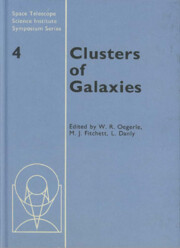Book contents
- Frontmatter
- Contents
- Preface
- Participants
- Chapter 1 Cosmology and Cluster Formation
- Chapter 2 Clusters of Galaxies: Structure, Infall, and Large-Scale Distribution
- Chapter 3 Cosmogony with Clusters of Galaxies
- Chapter 4 Cosmogony and the Structure of Rich Clusters of Galaxies
- Chapter 5 The Dark Matter Distribution in Clusters
- Chapter 6 The Effect of the Cluster Environment on Galaxies
- Chapter 7 Evidence for Gas Deficiency in Cluster Galaxies
- Chapter 8 Properties of Galaxies in Groups and Clusters
- Chapter 9 Dynamical Evolution of Clusters of Galaxies
- Chapter 10 Hot Gas in Clusters of Galaxies
- Chapter 11 Hydrodynamic Simulations of the Intracluster Medium
- Chapter 12 Evolution of Clusters in the Hierarchical Scenario
- Chapter 13 Distant Clusters as Cosmological Laboratories
- Chapter 14 Future Key Optical Observations of Galaxy Clusters
- Chapter 15 Cluster Research with X-ray Observations
- Plate section
Chapter 11 - Hydrodynamic Simulations of the Intracluster Medium
Published online by Cambridge University Press: 06 July 2010
- Frontmatter
- Contents
- Preface
- Participants
- Chapter 1 Cosmology and Cluster Formation
- Chapter 2 Clusters of Galaxies: Structure, Infall, and Large-Scale Distribution
- Chapter 3 Cosmogony with Clusters of Galaxies
- Chapter 4 Cosmogony and the Structure of Rich Clusters of Galaxies
- Chapter 5 The Dark Matter Distribution in Clusters
- Chapter 6 The Effect of the Cluster Environment on Galaxies
- Chapter 7 Evidence for Gas Deficiency in Cluster Galaxies
- Chapter 8 Properties of Galaxies in Groups and Clusters
- Chapter 9 Dynamical Evolution of Clusters of Galaxies
- Chapter 10 Hot Gas in Clusters of Galaxies
- Chapter 11 Hydrodynamic Simulations of the Intracluster Medium
- Chapter 12 Evolution of Clusters in the Hierarchical Scenario
- Chapter 13 Distant Clusters as Cosmological Laboratories
- Chapter 14 Future Key Optical Observations of Galaxy Clusters
- Chapter 15 Cluster Research with X-ray Observations
- Plate section
Summary
Abstract. A new, combined N-body and 3D hydrodynamic simulation algorithm is used to study the dynamics of the intracluster medium (ICM) in rich clusters of galaxies. Results of a program to study an ensemble of clusters covering a range of cluster richness within the framework of a cold dark matter (CDM) dominated universe are presented. Comparison with observations for both individual cluster characteristics and properties of the ensemble is emphasized. Predictions arising from the numerical models will be discussed and directions for future work in this area outlined.
INTRODUCTION
The intergalactic space in rich clusters of galaxies is permeated by a hot, ionized plasma which emits a continuum of X-rays generated by the scattering of energetic electrons off protons and ions. This thermal bremsstrahlung emission is observed to distances R ∼ 1 Mpc and spectral fits indicate temperatures T ∼ 108 K, so if the gas is confined by the gravitational potential of the cluster the binding mass must be of order M≃G−1(kT/μmp)R ∼ 3 × 1014 M⊙. The X-rays from the extended intracluster medium thus reflect emission from the largest relaxed, self-gravitating entities known in the universe.
The issues one would like to understand both observationally and theoretically range from the internal and structural—What are the spatial gas density and temperature profiles? Intrinsic shapes? How do these relate to optical properties? How do they evolve with redshift?—to the global and statistical—What is the expected abundance of clusters as a function of luminosity, temperature or any other observable?
- Type
- Chapter
- Information
- Clusters of Galaxies , pp. 287 - 326Publisher: Cambridge University PressPrint publication year: 1990
- 25
- Cited by



